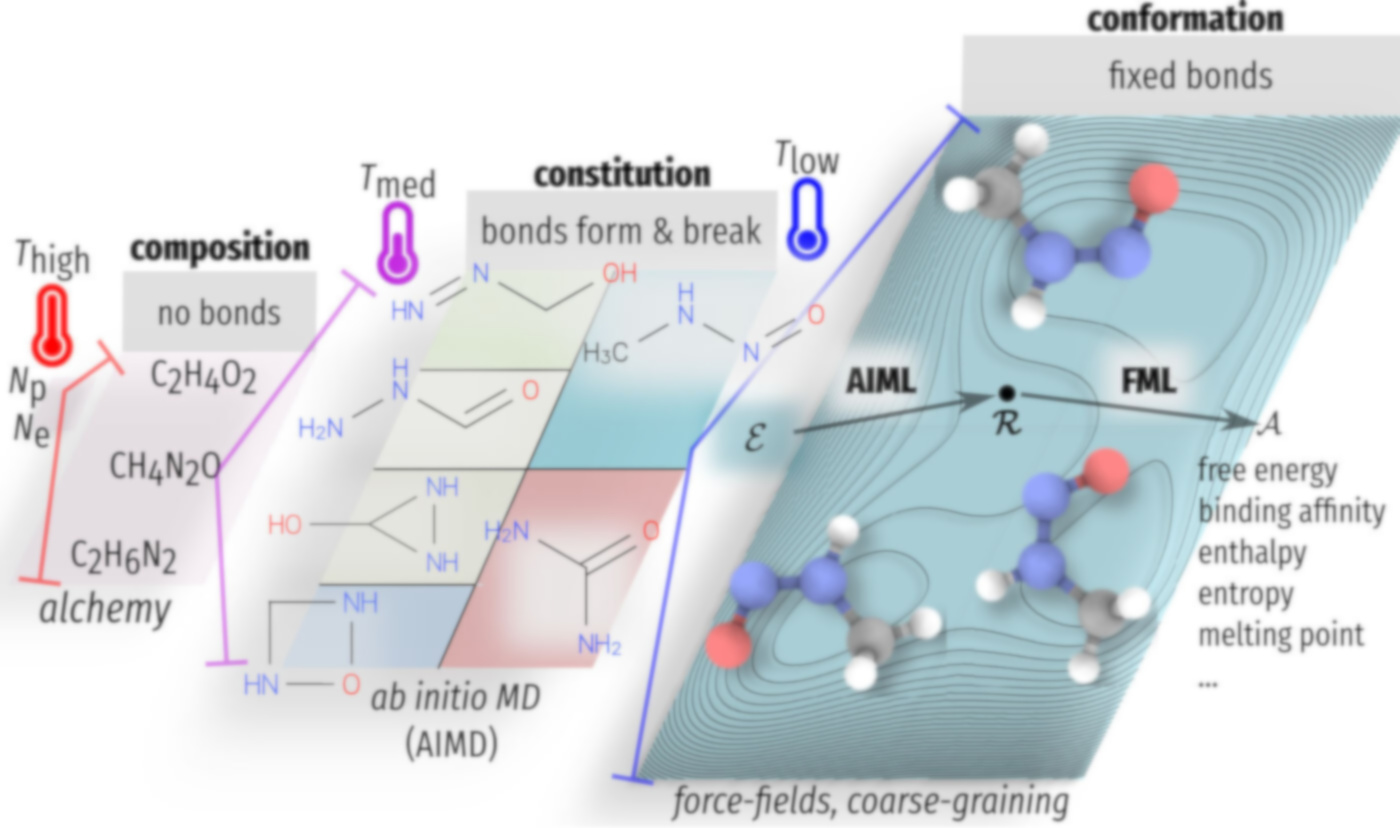OUTREACH
podcasts / videos / articles / general public
Podcasts
http://materials-and-megabytes.buzzsprout.com/190021/932717-o-anatole-von-lilienfeld-season-2-ep-2
Videos
Here is the YouTube channel of Anatole Lilienfeld: https://www.youtube.com/channel/UC68EGO9fI9L7aCRVyCfMcvw
Quantum Machine Learning in Chemical Compound Space, July 2020
IPAM “Introduction to Electronic Structure Calculations”, October 2019
IPAM: “Machine Learning for Physics and the Physics of Learning Tutorials” 2019
IPAM “Electronic Structure”, September 2019
“The Löwdin Lectures symposium part 2”, November 2018
Machine Learning For Nano Structures And Processes – Foresight Institute, May 2018
Science and Fiction : “Wann werden wir Überflügelt”, March 2018
Nomad Summer: “Quantum Machine Learning”, September 2017
NIPS: “Quantum Machine Learning”, February 2017
NIPS: “Panel Session – Cranmer, Murray, Welling, Carrasquilla, Louppe, Dahl, von Lilienfeld”, February 2017
Amons, July 2017
VR video, January 2017
IPAM: “Quantum Mechanics, Chemical Space, and Machine Learning”, September 2016
IPAM: “Machine Learning for Many Particle Systems”, February 2015
World Minds: The Huge Chemical Space, December 2013
Articles
An explorer of chemical space – Portrait at UNI NOVA, University of Basel Research Magazine, N°133 / May 2019
Interviews
10 Questions with Anatole von Lilienfeld and Gabor Csanyi (asked by the Thomas Young Centre (TYC) during the TYC Soiree on Machine Learning, Nov 2014)
We asked them…
- What is the best thing about your job?
AvL: Freedom
GC: The freedom to pick up any problem that I find interesting and have a chance at solving - What projects are you working on at the moment?
AvL: Many, all concerned with compound space
GC: My main interest is to develop new algorithms for simulating materials. We have a long running research programme to try and accurately fit the Born-Oppenheimer potential energy surface of an arbitrary material or molecular system using an interatomic potential. I am also interested in statistical mechanics, and thinking about the most informationally efficient way to extract thermodynamic properties from simulations - What is the most amazing single thing you could tell me about your field of research?
AvL: Compound space is unfathomably huge, and we haven’t even scratched its surface yet
GC: That we can predict how materials in the real world will behave just by thinking about them and using a big computer to solve mathematical equations - What is the biggest problem or challenge you face in your field?
AvL: Size of compound space
GC: Currently there is a heck of a lot of data being generated by vast supercomputers, both on the electronic structure and the thermodynamic properties of materials, but most of this data is “dark†after the corresponding publications have appeared, and sitting on hard drives without anyone making any use of them - What, from your area of research, would you like to know the answer to in your lifetime?
AvL: Can we make cheap drugs that inhibit aging or cheap materials that make energy abundant? Is there an analytical and universal expression linking the electronic density of one compound to another, and how does it look like? What is transferability? What is the damage due to the selection bias represented in the choice of chemicals which nature surrounded us with? Will we ever have a satisfying orbital-free density functional?
GC: Whether the solution of the full Schroedinger equation for electrons and nuclei really takes exponential effort, or if there is a polynomial shortcut. Does Nature really have exponential ‘computing capacity’? - What makes a good scientist or engineer?
AvL: Motivation, curiosity, perseverance, fantasy, creativity, friendliness, integrity and at least some writing skills (in random order and true for most professions)
GC: Curiosity – and honesty. You need a careful balance between enthusiastically pursuing an idea, but also being able to see what won’t work long before you’ve spent your life turning every stone - Who are your scientific heroes – dead or alive?
AvL: Gibbs, Planck, Einstein, Pauli, Boltzmann, Feynman, Wilson (all dead)
GC: - How do you think scientists can make their work accessible to the public?
AvL: Demonstrate its usefulness, or at least its promise to be useful one day. Improve teaching and writing skills. Improve science funding policies
GC: BBC Radio 4 has excellent science programmes, and seems to be able to call on an unending supply of scientists who are excellent communicators. They set a high standard to aspire t - What is your advice for anyone wanting to be a scientist or engineer?
AvL: Talent and education are helpful but not crucial. Study chemistry, it’s remarkable. Learn how to write. Don’t be afraid.
GC:Follow your dreams. Don’t be afraid to dirty your hands. Learn as early as possible to identify mentors worth learning from - Any last comments?
AvL: Who is John Galt?
GC: The above sounds a bit too serious. Science should be fun.
If you wonder what this is all about, here’s a recent Q&A session on combining machine learning with quantum chemistry to speed up the exploration of chemical compound space. You can also check out these reports in the New Scientist Feb 2012: Molecules from scratch without the fiendish physics, and on Chemistry World from the Royal Society of Chemistry, Dec 2011: Artificial intelligence for quantum chemistry.
And here’s Intel’s very own Sadas giving a TED talk on “designing new materials one atom at a time”.
And here’s Simon Elliot from Tyndall Institute talking about materials modelling for devices.
If you you have been thinking that quantum mechanics is irrelevant, here’s Walter Lewin on Heisenberg’s uncertainty.
Here’s a movie, depicting the quantum nature of atomic nuclei within a simplified model of Watson-Crick’s DNA base-pair (see also publication No. 23 for more information).
And if you don’t understand anything about this, rest assured, here’s a link to Richard Feynman telling you that neither do we.


